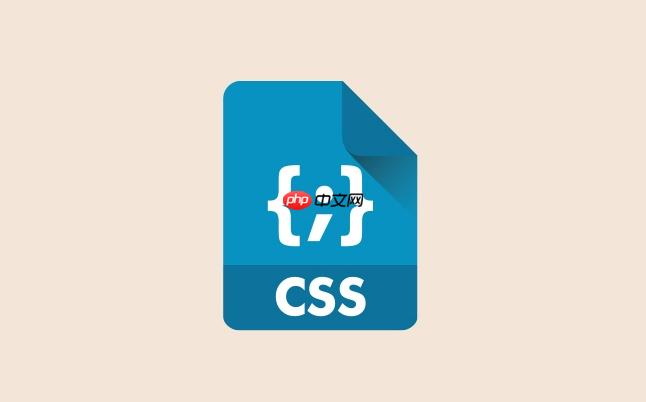答案:CSS边框样式通过border属性及其子属性(如style、width、color)、border-radius和border-image实现,常用样式包括solid、dashed、dotted、double及groove等立体效果,配合伪元素、clip-path或SVG可创建创意边框,响应式设计中需注意box-sizing、媒体查询调整及border-image适配,排查问题时应检查border-style缺失、box-sizing影响布局、优先级冲突和border-image设置。

CSS边框样式,说白了,就是给你的网页元素穿上各种“衣服边儿”。实现这些效果,我们主要依赖
border
border-style
border-width
border-color
border-radius
border-image
要实现各种CSS边框样式,我们通常从最基础的
border
border-width
border-style
border-color
一个最简单的边框是这样的:
.simple-box {
border: 1px solid #333; /* 1像素宽,实线,深灰色 */
padding: 10px;
}这里,
solid
border-style
立即学习“前端免费学习笔记(深入)”;
我个人最常用,也是最直观的几种样式:
solid
dashed
dotted
double
举个例子,如果你想给一个元素一个虚线边框:
.dashed-border {
border: 2px dashed blue; /* 2像素宽,蓝色虚线 */
padding: 10px;
margin: 10px;
}点线边框也类似:
.dotted-border {
border: 3px dotted green; /* 3像素宽,绿色点线 */
padding: 10px;
margin: 10px;
}双线边框在某些设计中也挺有意思的:
.double-border {
border: 4px double purple; /* 4像素宽,紫色双线 */
padding: 10px;
margin: 10px;
}除了这些,还有一些比较有立体感的样式,它们的效果会根据
border-color
groove
ridge
inset
outset
这些立体效果通常需要设置至少两种颜色,或者浏览器会自动根据边框颜色计算深浅。例如:
.groove-border {
border: 5px groove #ccc; /* 灰色凹槽边框 */
padding: 10px;
margin: 10px;
}
.ridge-border {
border: 5px ridge #ccc; /* 灰色凸脊边框 */
padding: 10px;
margin: 10px;
}如果你想让边框变得圆润,
border-radius
.rounded-border {
border: 2px solid #f06;
border-radius: 8px; /* 四个角都是8像素的圆角 */
padding: 10px;
margin: 10px;
}border-radius
border-top-left-radius
border-top-right-radius
border-radius: 10px 20px 30px 40px;
更进一步,如果你想用图片作为边框,
border-image
.image-border {
border: 15px solid transparent; /* 必须先设置边框宽度和透明样式 */
border-image: url('path/to/your/border-image.png') 30 round; /* 图片路径,切片30,重复方式为round */
padding: 10px;
margin: 10px;
width: 200px;
height: 100px;
}border-image
slice
round
stretch
border-image
slice
repeat
除了CSS原生提供的那些
border-style
一种非常强大的方式是利用
border-image
border-image-slice
border-image-repeat
border-image
.gradient-border-image {
border: 10px solid transparent; /* 边框宽度必须设置,且透明 */
border-image: linear-gradient(to right, red, orange, yellow, green, blue, indigo, violet) 1; /* 直接用渐变作为图片源,切片1(整个图片) */
padding: 15px;
margin: 20px;
width: 250px;
height: 100px;
display: flex;
align-items: center;
justify-content: center;
color: #fff;
font-weight: bold;
font-size: 1.2em;
}这种方式的优点是灵活性高,但缺点是图片资源可能增加,且在不同尺寸下可能需要调整
slice
另一种非常灵活的手段是利用伪元素(
::before
::after
z-index
.pseudo-element-border {
position: relative;
width: 200px;
height: 100px;
background-color: #f9f9f9;
padding: 20px;
margin: 30px;
overflow: hidden; /* 确保伪元素不会溢出 */
}
.pseudo-element-border::before {
content: '';
position: absolute;
top: -5px;
left: -5px;
right: -5px;
bottom: -5px;
border: 2px dashed #ff6b6b; /* 伪元素作为边框 */
z-index: 0; /* 确保在内容下方 */
}
.pseudo-element-border span {
position: relative;
z-index: 1; /* 确保内容在边框上方 */
}这个例子里,我用伪元素创建了一个虚线边框,它比实际元素稍微大一点,营造出一种“外框”的感觉。你甚至可以给伪元素设置
transform
rotate
对于更复杂的几何形状边框,比如一个六边形或者一个带有尖角的对话框边框,我们可能需要结合
clip-path
clip-path
.clipped-border {
width: 150px;
height: 150px;
background-color: #e0e0e0;
border: 2px solid #555;
clip-path: polygon(50% 0%, 100% 25%, 100% 75%, 50% 100%, 0% 75%, 0% 25%); /* 创建一个六边形 */
margin: 20px;
display: flex;
align-items: center;
justify-content: center;
font-weight: bold;
}这种方式实际上是裁剪了元素的形状,边框也会随之被裁剪。如果你想要一个真正六边形的边框,你可能需要用两个六边形元素叠加,一个作为背景(边框色),一个作为内容(背景色),并且尺寸略小。
最后,如果你真的需要极其复杂、不规则的边框,比如手绘风格的线条,SVG是最终的解决方案。你可以直接在SVG中绘制路径,然后将其作为背景图或者内联SVG嵌入到HTML中。SVG的强大之处在于其矢量性,无论放大缩小都不会失真,而且可以实现任何你能想象到的线条艺术。虽然这超出了纯CSS边框的范畴,但在“创意边框”的语境下,它绝对值得一提。
在响应式设计中处理边框,说实话,我个人觉得比想象中要重要一些,但又很容易被忽视。边框不仅仅是装饰,它会直接影响元素的尺寸和布局,尤其是在不同屏幕尺寸下。
首先,
box-sizing: border-box;
100%
border
padding
box-sizing: border-box;
border
padding
width
height
* { box-sizing: border-box; }/* 全局设置,强烈推荐 */
html {
box-sizing: border-box;
}
*, *::before, *::after {
box-sizing: inherit;
}
.responsive-box {
width: 100%; /* 假设父容器是100% */
padding: 10px;
border: 2px solid #ccc; /* 即使有边框和内边距,总宽度依然是100% */
}其次,边框的宽度在不同设备上可能需要调整。一个在桌面端看起来很精致的
2px
em
rem
vw
vh
我通常会这样处理:
.adaptive-border {
border: 1px solid #333; /* 默认一个较细的边框 */
}
/* 在小屏幕上,让边框更细或调整样式 */
@media (max-width: 768px) {
.adaptive-border {
border-width: 0.5px; /* 或者使用 0.05rem 等 */
border-color: #666; /* 颜色也可以调整 */
/* 甚至可以考虑在移动端移除某些复杂的 border-image 效果,以提高性能 */
}
}
/* 在超大屏幕上,可能需要略粗的边框来保持视觉平衡 */
@media (min-width: 1200px) {
.adaptive-border {
border-width: 2px;
}
}这里我用了
@media
还有一点,关于
border-image
border-image-slice
border-image-width
solid
dashed
border-radius
border-image
总结一下,响应式边框设计,核心在于
box-sizing
我个人在写CSS的时候,边框这块儿经常会遇到一些让人摸不着头脑的问题,明明代码写了,但效果就是不对劲。这其中有些是新手常犯的错误,有些则是更深层次的CSS特性导致的。
一个最常见的问题是:边框根本没显示出来! 这种情况,我通常会先检查以下几点:
border-style
border-width
border-color
border-style
solid
dashed
border-style
none
/* 错误示例:边框不会显示 */
.my-box {
border-width: 1px;
border-color: red;
/* 缺少 border-style */
}
/* 正确示例 */
.my-box-fixed {
border: 1px solid red; /* 或者分开写 border-style: solid; */
}border-width
0
border-color
transparent
另一个让我头疼的问题是:边框的尺寸影响了布局! 这几乎可以肯定是你没有正确使用
box-sizing
box-sizing: border-box;
border
padding
.container {
width: 300px;
background-color: #eee;
}
.item-a {
width: 100%; /* 期望是300px */
border: 5px solid red;
padding: 10px;
/* 实际宽度会是 300px + 5*2(border) + 10*2(padding) = 330px,溢出父容器 */
}
.item-b {
width: 100%;
border: 5px solid green;
padding: 10px;
box-sizing: border-box; /* 实际宽度依然是300px */
}当你遇到布局错乱,元素宽度不对劲的时候,第一反应就应该是检查
box-sizing
边框的颜色或样式看起来不对劲,或者不一致。 这往往是CSS的优先级(Specificity)问题。你可能在不同的地方定义了同一个元素的边框,而某个定义因为优先级更高,覆盖了你期望的样式。
!important
border-image
border-image
border-image-slice
30
border-image-repeat
stretch
repeat
round
round
stretch
border-width
border-image
border-width
border-width
transparent
表格边框合并(border-collapse
<table>
<th>
<td>
separate
<table>
border-collapse: collapse;
table {
border-collapse: collapse; /* 让单元格边框合并 */
width: 100%;
}
th, td {
border: 1px solid #ccc; /* 单元格边框 */
padding: 8px;
text-align: left;
}遇到边框问题时,我的经验是,不要急着改代码,先打开浏览器开发者工具。选中出问题的元素,查看“样式”和“计算”面板。通常,你能在那里找到冲突的CSS规则、错误的属性值或者没有生效的样式,这比盲目修改代码效率高得多。
以上就是CSS边框样式怎么做_CSS实现各种边框样式效果的详细内容,更多请关注php中文网其它相关文章!

每个人都需要一台速度更快、更稳定的 PC。随着时间的推移,垃圾文件、旧注册表数据和不必要的后台进程会占用资源并降低性能。幸运的是,许多工具可以让 Windows 保持平稳运行。

Copyright 2014-2025 https://www.php.cn/ All Rights Reserved | php.cn | 湘ICP备2023035733号